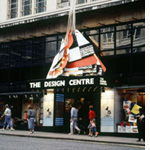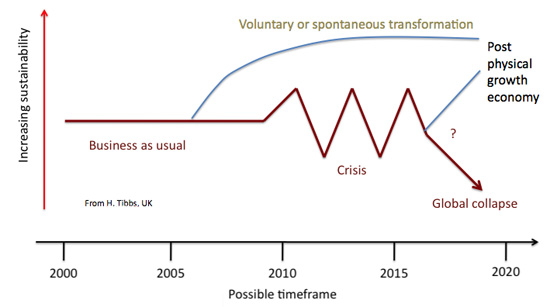Doing Good Projects
To Do Good!

To do good projects have been on the increase recently. Social responsibility and ethics have taken over from profit and business innovation as the most discussed issues in design schools. The world of Al Gore, Bono, Architecture for Humanity and Design Without Boundaries has entered the design schools and even to some extent the design centers and media. Today, when visiting design fairs one wonders about the motivation of designers and producers displaying things that not many have use for (see previous blog about the Stockholm Furniture Fair).
Implementation of Doing Good Design
But many projects wanting to do good for society and the environment have landed in difficult pitfalls during implementation and execution. The utopian driven Romanticism that one senses in the studios meets trouble when it hits reality. I wonder if we do not need to introduce a different working environment and competence into the design education.
Short Design Perspective
 I am not going to disseminate design history here, but a stepping stone history can be seen this way: Design gained its independence trough the work of William Morris and many others in the end of the 19th century. It was born out of manufacture and mass-production of every day things that previously was made by local craftsmen. The manufacture was based on the philosophy of the crafts, maybe culminating in the Bauhaus ‘crafts to industry to multi production’ musical.
I am not going to disseminate design history here, but a stepping stone history can be seen this way: Design gained its independence trough the work of William Morris and many others in the end of the 19th century. It was born out of manufacture and mass-production of every day things that previously was made by local craftsmen. The manufacture was based on the philosophy of the crafts, maybe culminating in the Bauhaus ‘crafts to industry to multi production’ musical.
National Design Policy (Bella Centre, Norsk Form, Design Museum, etc)
After the Second World War national design activism gained momentum resulting in the establishment of design councils, design centers and national design policies. I remember the Design Centre in Haymarket, London displaying ‘good design’ items, various exercises in form with application to function. Now, most national capitals and major cities have design centers that promote something that is named ‘Good Design’ based on advice from people that had the licence for proper form, proper materials and proper designers. All very boring. 70′s, 80′s and 90′s design fashion then developed into a celebrity culture of faces on covers of magazines, more idiotic designs like a sofa for stupid prices designed by Saha Hadid, Pawson etc. Everyone
 competed to outdo the others in extravagance. I am not blaming people directly but the zeitgeist. I was an architect in the late yuppy 80′s and did some rather cracy things. My only excuse is that it is possible to change. We have many examples of the same like Tim Brown talking about toothbrush design in the Intersections conference 07: “When I think about this, I kind of get a little bit depressed. It makes me feel less great about what I do as a designer.” Same goes for Philip Starck in Ted Conferenceapologizing for his actions in the Nineties.
competed to outdo the others in extravagance. I am not blaming people directly but the zeitgeist. I was an architect in the late yuppy 80′s and did some rather cracy things. My only excuse is that it is possible to change. We have many examples of the same like Tim Brown talking about toothbrush design in the Intersections conference 07: “When I think about this, I kind of get a little bit depressed. It makes me feel less great about what I do as a designer.” Same goes for Philip Starck in Ted Conferenceapologizing for his actions in the Nineties.
Romantic Socialism
Morris was of course a socialist, meaning to make the world better and more beautiful for the middle classes, like IKEA has managed to succeed with. Le Corbusier was a devoted salon communist, proposing social solutions in the city and the home while working for the affluent. The 60′s and the 70′s were dominated by architectural projects in housing and urban planning wanting to create social solutions for the every-man (whoever that is?). This all culminated in determinism for the masses and architects and planners became the most hated professions in the late Seventies and ultra self indulgent Post Modernism took over. I was one of them. I remember a slogan in our office: ‘If you can make it more complicated, do so!’
Innovation
Around the millenium commerce came into the force in the design field and innovation became the most used word. Governments started to look at design as part of innovation, we were courted by business and industry as the new way to make profit. And designers and design theorists participated in this, we took part in many projects and research into innovation and the creative industries. Out came the Cox Review, funds from the Nordic Innovation Centre, co-projects with the business schools became the norm. I have participated in such projects, sometimes being surprised that I was the only designer in the group! The US magazine Business Week asked recently ‘Are the Design Schools the new Business Schools?’
Environment, Society and the Developing World.
But underlying the Noughts has simmered the realization that things are maybe not going so well, and the small group of eccentrics actually might be right. With awareness of global issues like climate, developing countries resulting in organic commerce, ethics, fairtrade etc has come into force. I have been running projects where my students of design have worked in groups with students from business universities since the beginning of this century. The orientation of the projects has changed dramatically in the direction that now over 90% of the projects involve ethical, social and climate issues while the early days the projects were much more commercial. The worst case being a project in producing and selling stencils for the barbering of ladies pubic hair!

The futurist H. G. Tibbs proposed in 1998 how things might happen in the years after the millenium. The diagram shows his ideas, and it seems that his proposal was quite right. There has been an underlying anxiety about where we are heading and many spontaneous activities have resulted. This spontaneous activity that he proposes results for example in various ‘To Do Good’ projects. They are driven by Utopianism. A need to be nice to ‘the other’ like Madonna and many celebrities adopting African children etc. My opinion is that very many of these projects do not succeed because they do not have anchored strategies and do not know how to act in complicated political situations and cultural diversity. The actors struggle and in many cases decide to do ‘safe’ projects like helping South-American women in making toys for children. But the toys have no way of reaching the market that needs them and much of the Western market has actually no need for the products. This results in disappointment and Western subsidy of products that just increase the rubbish in the modern Western home that is full of Playstations and mobile phones.
It is fine to walk around with a basket made by African women. It is fine to eat organic Kenyan beans. It is fine to adopt third world children. These are all small acts of good, but the task is so much bigger and time is too short and most of these acts are self indulgent and in some cases reinforce the differences between the rich and the poor. They are bread-crumbs from the affluent.
Friend Richard Kroecker in Halifax came for a visit to tell us about the Pictou Landing Health Centre he produced in a remote village in Canada. Most of the difficulties that they came against and the tricks they had to do were to deal with Canadian government standards and procedures. Kate Stohr from Architecture for Humanity came here to tell us about their work and in her explanation about the project in post-Catrina she told about planning laws, financing, governmental agencies. The house design was actually not the most important task!
Design and Infrastructure
The design schools do not consider infrastructural issues very important. The schools are still based on the old Form/Crafts/Products principles. The teachers are many educated in art schools where the idea of the Renaissance heroic artist still prevails. The design centers are similarly driven by the same policies and design agencies that want to do social projects do not realize the implications of complex politics, marketing and cultural differences. The design schools have more focus on entrepreneurship, but mostly towards business and industry. This is good, but issues of social entrepreneurship are needed. I have been involved in service design projects and they, while they are about people and services, do concentrate on profit for the service provider more than the benefit for the user.

I have made two diagrams of project development. The first one shows the ideal project where the process goes from start to end in a beautiful direct line representing actions and results. This is a possible scenario for the individual craftsman who through rigourous training can be trusted to deliver results, like a good piece of a ceramic pot in the controlled situation of the ceramic studio.

The second diagram (inspired by the French philosopher Gilles Deleuze and furniture designer Bernard Cache) shows the actual process, where external factors direct the project off course to various problematic situations. For those that are not driven by vision and with entrepreneurial skills it is a difficult process, lots of anxiety and trauma, with pitfalls and trouble all the way. No wonder many of the designers do not risk taking on such a project. It is better to create simple projects that can be proudly displayed in galleries rather than implemented in society where often the results are invisible to the design media. Those designers have less chance to have their face on a cover of a magazine, given prices for ‘Good Design’.
The design and crafts schools and the practical reality after school are seen as protected studios and worshops, almost like sheltered work place for handicapped people rather than social, political and entrepreneural activities for the good of society.
————————————————-comments———————————————————–
 It has to do with the fact that designing ends at the prototype (whether it is an object, or a concept, or a “transformation”) as such it often fails to fully engage with the complex processes and issues of implementation.
It has to do with the fact that designing ends at the prototype (whether it is an object, or a concept, or a “transformation”) as such it often fails to fully engage with the complex processes and issues of implementation.
Socially responsible project “failures” that I have experienced have often had one of two sources: the failure to be implemented or the failure to scale the implementation in order to have measurable impact.
My health financial information project for Chicago Cook County Bureau of Health Services failed because the employees directly blocked its implementation through stonewalling. Why did they act that way? The project would have made more transparent their processes, which they wanted to keep private, so they sat on the warehouse of designed artifact systems and processes until I ran out of energy trying to both adapt the design to the bureaucratic culture, yet bring about change in the culture. As an anthropologist, the most challenging thing to do is to change institutional cultures.
Thinking of the Design for Democracy example, it is mired by the fact that it cannot scale to have national impact, although it has been approved by the Fed gov as the national standard for ballot design and polling place information and the templates to implement the system is widely available. AIGA, the sponsoring organization, does not have the resources (staff and money) to convince all 3,421 counties to adopt the standard. The Fed government cannot mandate the changes due to the Constitution. So even though it has been successfully implemented, it will lag in its ability to scale.
But failure is always a question of for whom and under what time frame. Is DforD a failure because it will take 10 years to have full acceptance instead of 2-3 years? If Cook County rolls out the design system because a new Lt. Government applies pressure, will it still be a failure?
Perhaps socially responsible projects “fail” because the temporal scale of change is longer than the temporal engagement of designers.
 Brilliant question and response, so far – I agree with Dori T. insofar as timescale…this is not confined to socially-oriented projects – it is also true in many governmental projects [e.g. the last 7 major computer systems in UK] that failed through their complexity<?>…..also because small deceits, optimisms and incompetences remained invisible or seemed trivial until the whole scheme was switched on. We are looking at a redesign of design to include self-steering of the whole co-design system…..[must get some sleep now:)
Brilliant question and response, so far – I agree with Dori T. insofar as timescale…this is not confined to socially-oriented projects – it is also true in many governmental projects [e.g. the last 7 major computer systems in UK] that failed through their complexity<?>…..also because small deceits, optimisms and incompetences remained invisible or seemed trivial until the whole scheme was switched on. We are looking at a redesign of design to include self-steering of the whole co-design system…..[must get some sleep now:)
 I wonder if this is to do with the how design has been implemented previously in society.
I wonder if this is to do with the how design has been implemented previously in society.
Very practical implementation of a logo, or here is a new chair. These are easy to understand, but not necessarily easy to measure the effect. (Does a new chair really make the world a better place? etc.) Well there has been some quantitive measurement of the effects of design as well national feedback from things like the Cox Report etc.
However, Socially Responsive Design, or the implementation of ideals is harder to measure. How do we measure design that changes our behavior as human beings? Where is the evidence for the effect of this sort of intervention?
 Well…ok. Let’s talk turkey.
Well…ok. Let’s talk turkey.
If you look at the batting average of commercial firms– how many designs they take through schmatics vs. how many they see through fruition. I’d wager it’s about 10 unrealized projects to every 1 realized project.
At www.architectureforhumanity.org, we have the same batting average. We’re about 10 to 3…and then only because we don’t have the manpower to take more projects through pre-development.
So, i think you have to look at it from a different lense.
Also many projects do good without being do-gooder projects. We should not underestimate the value of sustainable design in the construction of offices, warehouse space, and the manufacture of products.
We’ve seen a seachange in the way the industry works. We are helping our clients become better stewards… so again, look out outcomes not output.
kas
 February 2, 2009
February 2, 2009
 Posted in: DESIGN, PONDERINGS
Posted in: DESIGN, PONDERINGS

